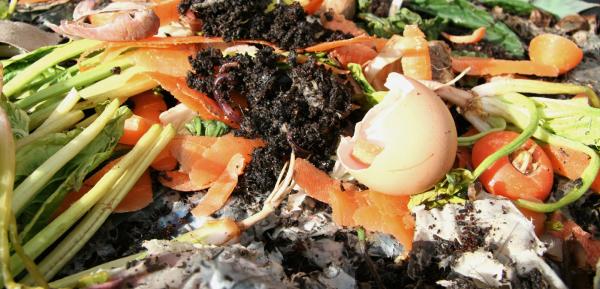How Worms Saved a School District over $6,000 in Dumpster Fees

Vermicomposting — using worms for composting — provides a way for waste management and reduction to become part of the academic curriculum.
Today's students are hungry for work that is real, for learning that is meaningul.
Project-based learning is a teaching strategy that allows students to take more responsibility for their learning as they make decisions and create solutions to problems that interest them. All subjects can be integrated as students apply their academic, social, and life skills to their work. As schools change, so will our impact on the future. Project-based learning is a teaching strategy that honors students as capable people, readying themselves to be future leaders by giving them chances to be leaders as children.
Today, population growth and changes in society have led to more people and fewer natural resources. It now becomes important to heed new educational imperatives. Reduce, reuse, and recycle are major economic corollaries of vermicomposting. The organism central to the biological technology of vermicomposting is the earthworm.
Earthworms are animals in a group we know as invertebrates, which have no backbones. They are in the phylum Annelida and are commonly called annelids. Earthworms are exceptionally valuable to the environment, Without their constant burrowing, the soil would lack good drainage and aeration, and their nutrient-rich castings would not be mixed into its upper layer. School vermicomposting projects and school gardens, begun by Laytonville [California] Middle School in the fall of 1987, can demonstrate that communities can reduce their use of local landfills, water, and fossil fuels.
Earthworms did help the elementary and middle schools in Laytonville reduce use of both pesticides and natural resources. Avoiding the use of pesticides on school grounds and in school gardens is possible because nutrient-rich worm castings applied to the soil maintain soil health.
Parents, community members, teachers and students worked together to avoid the use of pesticides on our school grounds. We were concerned about the long-term effects of pesticide use on our students. Some teachers felt there was a connection between some of the systemic pesticides being used on our grounds and an increase in headaches and nosebleeds experienced by some of our students. Using vermicompost as a soil amendment helps improve the tilth, nitrogen, and pH of the soil. The improved tilth causes less leaching of nutrients out of the soil and contributes to a healthier soil full of microorganisms, including earthworms, that help increase the yield of crops grown in our school garden. Soil and crops that are healthy are less likely to be attacked by insects and disease. We have also reduced our use of commercial fertilizer.
Because the schools relied on worms on-site instead of using gasoline-powered trucks for transportation to a recycling plant 25 miles away to process paper wastes, they actually reduced fossil fuel use. Water conservation was another objective of the comprehensive organic gardening program. Mechanical garbage disposal in a kitchen sink requires eight gallons (30 liters) of water to dilute one pound of food waste. Because Laytonville schools no longer wash food waste down the drain and, in addition, reuse rinse dishwater to swish out empty milk cartons before transporting them to the recycling center, they used 103,680 fewer gallons (394,000 liters) of water a year after beginning the program than they consumed the previous year.
Above all, vermicomposting reduces solid waste at its source. Every year people in the state of California throw away 146 million tons, (132,700,000 t) of trash. Each person is responsible for generating about one ton of waste each year. Of that waste, 880 pounds is paper, 200 pounds is glass, 180 pounds is metal, 140 pounds is wood; another 140 pounds consists of cloth, rubber, plastic, and leather; and 460 pounds is yard waste. Schools top the list of sources for discarded paper and food waste. Mid-scale vermicomposting provides a simple, effective, and inexpensive method for processing paper and food wastes that requires no transportation to a central location for further processing. At the same time, mid-scale vermicomposting empowers students to feel they can, and do, make a difference to the positive economies of their town through active stewardship of the natural resources they use.
During the program's first school year, a ten-month period (not a 12-month calendar year), Laytonville vermicomposted 3,600 pounds of cafeteria food waste and fed 9,360 pounds of protein food waste to chickens and pigs. The schools recycled 567 pounds of milk cartons and 654 pounds of tin cans. Adding these numbers shows that more than seven tons of solid waste were effectively diverted from one local landfill.
That first year of mid-scale vermicomposting, the school district saved $6,000 in dumpster fees by reducing the amount of paper and food waste collected in commercial dumpsters that eventually went to the landfill. Janitors also spent less time handling trash-can waste. Five years later, this successful vermicomposting program for a school population of 400 students continues to provide a model for student citizenship.
Besides helping reduce the flow of food waste to landfills, mid- scale vermicomposting provides schools with unique study opportunities. An introduction to small business practices arises as staff and students conduct worm workshops and sell both worms and vermicompost to the workshops, and sell both worms and vermicompost to the community. Students also experience mathematical concepts and scientific methods close-hand: measurement, ratio and proportion, area, temperature, observing, predicting, testing, comparing, and contrasting. There is not a better vehicle than a worm bin for the study of a healthy ecosystem.
A vermicomposting bin is an alive and extremely complicated system. Interdependence, flexibility, diversity, cooperation, and sustainability are all represented in a vermicomposting bin. The inhabitants are so interrelated that to study the system in separate parts is impossible. Worm bins are not just collections of plants, animals, and bacteria. Worm bins are communities involved in complex relationships. Within the walls of a worm bin, millions of creatures are dependent on one another for survival, while others are content to share a desired environment or food source. So, to understand the dynamics of worm bins, we must first look to, and understand, relationships.
Our combined vermicomposting/organic-gardening program is successful because it is systemic. In life, we can find many types of systems — health systems, educational systems, transportation systems, and so on. Each system is dependent on its many parts which must be organized and integrated if the system is to survive and flourish. Systems thinking, or systems engineering, focuses more on coordination of the total system rather than on its individual parts. Systemic programs are methodical, ordered and comprehensive.
Vermicomposting is cyclical in nature. The school, a system itself, is in many ways very much like an ecosystem. Energy and matter move through the school community and, like a healthy ecosystem, many substances are recycled. The understanding of connectedness in this process is invaluable, realizing that we do not make decisions in isolation and that our every action has an equal or greater reaction. Actions of each person directly involved in the cycle guarantee the success of our vermicomposting project which does not depend on special circumstances. It is very simply managed by children with the aid of adults. Vermicomposting has become a part of daily life in our school cycle.
Implementing a successful mid-scale vermicomposting program at your site begins with a shifting of old paradigms, and with the vision and willingness to make a difference in your community and in the world. Always involve as many people in the initial process as you can. Involvement by others will achieve more "buy-in" and a greater long-term success rate for your program.
Checklist for Successful Mid-Scale Vermicomposting
- Conduct a waste audit. Parents, community members or a group of students can do this.
- Get funding. Pacific Gas and Electric gives mini-grants for projects that reduce waste generated on site. The American Association of Nurserymen gives grants to schools. The National Gardening Association in Burlington, Vermont, also gives small grants to schools.
- Involve all staff from the very beginning of the project. Start with students and staff meeting together to develop a plan. Keep one another informed every step of the way.
- Purchase the materials and have students assemble bins with staff or volunteers.
- Start small. Start where you can and build up the program as you go. Don't wait.
- Set up a schedule for waste flow. Provide clipboards for each bin.
- Monitor and record the daily health of the bins.
- Have students report their project to the school board. Invite local news personnel to the school. Have students conduct workshops on vermicomposting for the community.
- Use the castings to grow vegetables in the school garden or to nourish plants that beautify the school grounds.
- Know you are making a difference one step at a time.
Excerpted from Binet Payne, The Worm Café: Mid-Scale Vermicomposting of Lunchroom Waste — A Manual for Schools, Small Businesses, and Community Groups (Kalamazoo, MI: The Flower Press, 1999).




